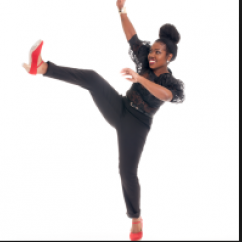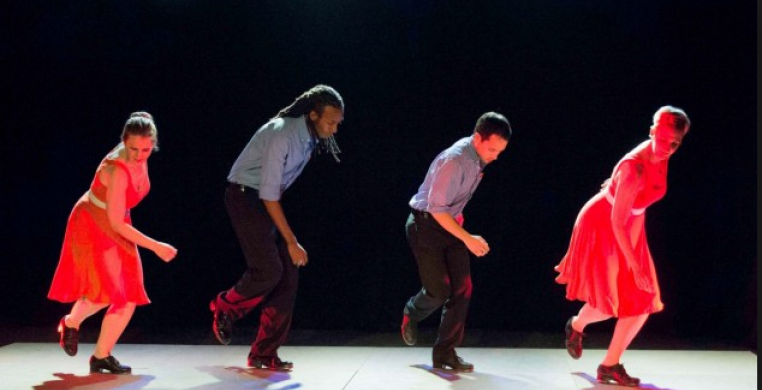Before Phil Brooks’ stand-up routine introducing “Persist,” the latest installment of Audible Odyssey’s fanfare for Chicago tap dance (8 PM, May 26-27, Stage 773), tappers drifted onto the raised wooden sound board of a stage, shuffled and ball-heeled casually into circle formation, and began keeping the beat.
They went around the circle one at a time, each in turn taking a 16-bar riff. Amicable rhythmic one-ups-man-ship built with individual licks as the circle of old pros, newbie teens, and seasoned hoofers of all stripes sustained the pulse. Four or five rotations made for a fun start, but, as good as these tappers were, when the game didn’t develop beyond its original premise, ten more rotations became merely repetitive. Compounding this was the fact that we really couldn’t see the dancers’ faces or whole bodies. Enclosed in the circle with their backs to the audience, it was almost as if performing for an audience was secondary to just having a great time stirring up a lot of sound with their feet.
On the plus side, the warm-up sent a clear message of tap dance solidarity among a veritable catalogue of Chicago tap dance, including tappers with current or past associations with Chicago Tap Theatre, MADD Rhythms, BAM!, The Cartier Collective, Especially Tap Chicago, and jorsTAP Chicago. Another clear message is how socially unifying tap dance has been and continues to be in Chicago. This was apparent in the happy camaraderie the program inspired in the diverse audience—kids, grandparents, hipsters, cool dudes, moms and dads, dates, cubs fans and bunheads from every corner of Chicago’s neighborhoods.
The focus of this chapter in Audible Odyssey’s six-year history is “Tap Dance Made By Women.” Discernibly female perspectives were in evidence in three of the six works. Most notably, it was refreshing to encounter Kristi Burris’ “Break Down Up” (world premiere), half-way into a program that was, up to this point, heavy on sound, feet, and rhythm, with hard-driving foot action and strong attack, but little upper body movement and minimal spatial design.
Burris pushes the boundaries of genre in a blend of modern dance, soft shoe, and tap in three sections, each in a different mood—“Sad,” “Angry,” and “Hopeful”—each set to a different song. “Sad,” an emotionally-driven soft-shoe poem, is the most striking of the three sections. Set to the song “Obsolete,” by Regina Spektor, this is a dance that is about something, as the lyrics convey, “This is how I feel right now.” But Burris doesn’t hitch a free ride on the music. Her dancers’ liquid spines collapse and unfold, arms expand in supplication and surrender, and a rich vocabulary of turns, extensions, and spirals paints a portrait of loss that goes well beyond sad without becoming maudlin. “Angry” devours the space with insatiable appetite in a women’s duet that reaches extremes of conflict and intimacy. “Hope” introduces two large fabric cubes that add visual intrigue but are otherwise not used to choreographic advantage once they have served their purpose of masking a change into tap shoes, the entrance of two additional dancers, and an explosion of metallic confetti. Jazz moves, pirouettes, and hand-clapping combine in a peppy tap celebration that ends on a high note. Kristi Burris
Kristi Burris
Patti Vickerman’s “Suite Pete” (world premiere) is just that, a sweet, traditional tap dance take on three vintage classics: “Night and Day,” “I love Paris,” and “They All Laughed.” Her soft touch and the more subtle tap attack respect the partnership of song and dance from the 40’s jazz era in a mostly unison structure, pleasing if conventional, that sets these five women in tea dresses on a gentle trip down memory lane.
You might think tap dancing to the Israeli national anthem, “Hatikvah,” is a recipe for incongruity, but Kendra Jorstad's lyrical use of tap actually carries off a tap sonata on women's will—longing, mourning, hoping and surviving in the face of struggle. Clearly these are women’s moves—weeping, beseeching, reaching, teetering on the edge. Using a gestural language that incorporates both literal mime and abstract port de bras, Jorstad manipulates changing spatial configurations to develop her movement material with solid thematic structure. Most striking is her use of tap rhythms and subtle attack to orchestrate the music.
The most interesting part of Jenna Deidel’s “Best Medicine,” is her use of tap to mimic the run-on sentences, alliteration, onomatopoeia, and plays on words in Geogre Carlin’s monologue, “Modern Man,”—clever, original, and quite interesting, but for the fact that the loudness of the tapping often obscured Carlin’s speech. Deidel states in a program note to have been inspired by comedic timing, but the overly-literal illustration of Tom Minchin’s lyrics to “Not Perfect” in part 2 misses the mark. Connecting the timing and rhythms of tap to comedy is an intriguing idea worth further exploration.
Megan Davis’s “Sigma fi i” adds a light frolic of funky jazz tapping for seven mostly unison dancers to Herbie Hancock’s “Fat Mama,” while Starinah Dixon’s “Ultralight Beam” pulls out all the stops for a show closer that shows off her amazing technique and joie de vivre. Starina Dixon
Starina Dixon


